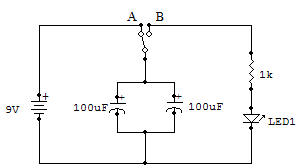
The Electronic Gas Tank

In our last Project Capacitors in Series and Parallel we mentioned that capacitors can store electricity. That means you can think of capacitors as being like the gas tank of a car, you can store electricity in a capacitor and then use it when you need it.
This Project will let you see how these "electronic gas tanks" work. Before you make the final wiring connection, be sure the Select Switch is set to A.
Look at the schematic and you can see that in this position current flows from the Batteries through two 100uF capacitors connected in parallel.
Now set the Select Switch to B. What does LED 1 do?
As you saw, LED 1 glows for a few seconds and then goes out. This happens because LED 1 draws electricity from the capacitors until all the charge stored in them is exhausted.
To recharge the capacitors, set the Select Switch to A for a few seconds. When you again set the Select Switch to B, LED 1 will again light. Do you think LED 1 will stay on longer if you let the capacitors charge longer?
Try different charging times and try to find out. Do you think there is a limit to how much electricity a capacitor can hold?
We've used "uF" to describe capacitors. That's short for microfarads. Farads are the units we use to measure capacitors (like we us ohms for resistors).
Farads indicated how much electricity a capacitor can store. But farads are too big for use with electronic circuits, so most capacitors are measured in microfarads (uF) , which is one-millionth of a farad, or picofarads (pF), which is a millionth of a microfarad (now that's what you call a small charge!) see Capacitors pF to µF.
